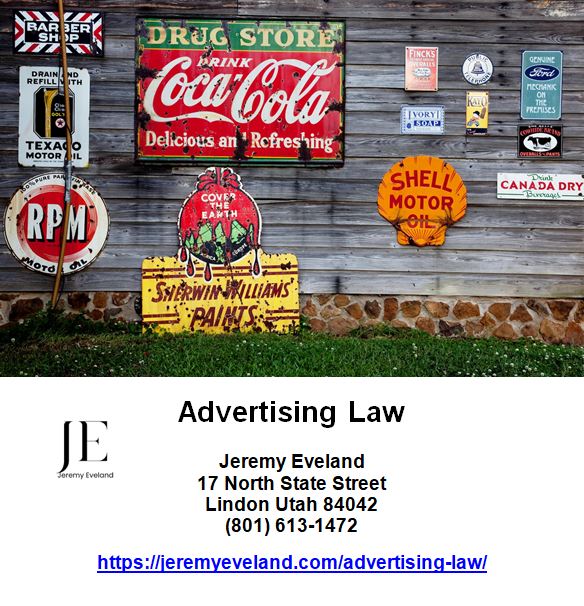Misleading Advertising is a concise and informative article that sheds light on a prevalent issue faced by businesses today. This article aims to provide readers with a comprehensive understanding of the legal aspects surrounding misleading advertising, ultimately leading them to seek professional advice from the lawyer listed on the website. Tailored for business owners and companies, this article delves into the implications of misleading advertising, while also addressing frequently asked questions and offering brief yet insightful answers. By equipping readers with the necessary knowledge, the article empowers them to make informed decisions and take necessary action.
I. What is Misleading Advertising?
A. Definition of Misleading Advertising
Misleading advertising refers to the act of promoting a product or service in a false or deceptive manner, leading consumers to make purchasing decisions based on inaccurate or incomplete information. This form of advertising misrepresents the features, benefits, or quality of a product or service, creating a false impression in the minds of consumers.
B. Types of Misleading Advertising
There are several types of misleading advertising tactics that businesses may employ to deceive consumers:
-
Exaggerated Claims: This involves making statements that overstate the product’s capabilities, performance, or benefits. These claims can persuade consumers to believe the product is better than it actually is.
-
Hidden Fees and Charges: This occurs when a company fails to disclose additional fees or charges associated with a product or service, only revealing them after the consumer has made the purchase decision.
-
False Comparative Advertising: This tactic involves comparing a product to a competitor’s product in a way that is misleading or inaccurate, giving the impression that the advertised product is superior.
-
Bait-and-Switch: This deceptive practice lures consumers in with an enticing offer, only to switch it for a higher-priced or lower-quality alternative once the consumer is committed to the purchase.
-
Misleading Fine Print: Companies may bury important information or disclaimers in small text within their advertisements or contracts, making it difficult for consumers to spot and fully understand the terms and conditions.
C. Laws and Regulations Regarding Misleading Advertising
To protect consumers from deceptive advertising practices, various laws and regulations have been established. In the United States, the Federal Trade Commission (FTC) is responsible for enforcing truth-in-advertising laws. The FTC prohibits false or misleading claims and provides guidelines for businesses to ensure their advertising is truthful and transparent. Additionally, individual states may have their own consumer protection laws that address misleading advertising practices.
II. Common Tactics Used in Misleading Advertising
A. Exaggerated Claims
One of the most common tactics in misleading advertising is the use of exaggerated claims. Businesses may make statements about their products or services that go beyond their actual capabilities or benefits. For example, a beauty product may claim to completely eliminate wrinkles, despite having limited effectiveness. These exaggerated claims can mislead consumers into believing the product will deliver unrealistic results.
B. Hidden Fees and Charges
Hidden fees and charges are another deceptive tactic used in advertising. Companies may fail to disclose additional costs associated with a product or service until after the consumer has made the purchase decision. This can lead to surprise expenses and dissatisfaction among consumers who were not fully aware of the total cost before making a purchase.
C. False Comparative Advertising
False comparative advertising involves comparing a product to a competitor’s product in a way that misrepresents the truth. This tactic aims to create a perception that the advertised product is superior or offers better value. For example, a company might claim that their product is “50% more effective than leading brands,” even if there is no evidence to support this assertion.
D. Bait-and-Switch
The bait-and-switch tactic is designed to attract consumers with a desirable offer, only to substitute it with a less desirable alternative. For instance, a retailer may advertise a product at a heavily discounted price, but when consumers arrive to purchase it, they are informed that the item is out of stock or no longer available. The company then tries to persuade the customer to purchase a higher-priced alternative instead.
E. Misleading Fine Print
Misleading fine print involves burying important information or disclaimers in small text within advertisements or contracts. This can make it difficult for consumers to notice or understand the terms and conditions associated with a product or service. As a result, consumers may unknowingly agree to unfavorable terms or be caught off guard by unexpected provisions.

III. Consequences of Misleading Advertising
A. Potential Legal Ramifications
Engaging in misleading advertising can have serious legal consequences for businesses. Violations of truth-in-advertising laws can result in enforcement actions by regulatory agencies, such as fines, injunctions, and mandatory corrective advertising. Additionally, affected consumers may file individual or class action lawsuits against companies, seeking monetary damages for any harm they suffered as a result of the deceptive advertising.
B. Reputational Damage
Misleading advertising can severely damage a company’s reputation. When consumers discover that they have been misled, they are likely to lose trust in the brand. This can lead to negative word-of-mouth, social media backlash, and a tarnished reputation in the marketplace. Rebuilding trust and restoring reputation can be a challenging and costly endeavor for businesses.
C. Loss of Consumer Trust
One of the most significant consequences of misleading advertising is the erosion of consumer trust. When consumers feel deceived or manipulated, it is unlikely that they will continue to support or purchase from the offending company. Loss of consumer trust can have long-term repercussions, including decreased customer loyalty, reduced repeat business, and a negative impact on the overall brand image.
D. Decreased Sales and Revenue
Misleading advertising can ultimately lead to decreased sales and revenue for businesses. As consumers become more aware of deceptive practices, they are less likely to make purchases from companies that have been associated with misleading advertising. This decline in consumer confidence can translate into reduced sales and a decline in the company’s bottom line.
IV. Real-Life Examples of Misleading Advertising
A. Case Study: XYZ Company’s Deceptive Claims
In a recent case study, XYZ Company was found guilty of engaging in misleading advertising. The company’s weight loss product claimed to help consumers lose 15 pounds in just one week without any changes to their diet or exercise routines. However, it was revealed that the product had no scientific evidence to support these claims. As a result, the company faced significant legal consequences, including hefty fines and a damaged reputation.
B. Lawsuits Against Companies for Misleading Advertising
Many companies have faced lawsuits for misleading advertising. One notable example is a large telecommunications company that advertised unlimited data plans but later throttled customers’ internet speeds after they reached a certain usage threshold. The company was sued by consumers who felt deceived by the false advertising and sought compensation for the impact it had on their internet experience.
C. Notable Examples from Recent Years
In recent years, several high-profile cases of misleading advertising have made headlines. An automobile manufacturer faced backlash when it was discovered that the fuel efficiency claims in their advertisements were significantly overstated. Similarly, a fast food chain received negative attention when it was revealed that the actual appearance of their advertised burgers did not match the visually appealing representations shown in their advertisements. These examples serve as reminders of the potential consequences that companies can face when engaging in deceptive advertising practices.

V. How to Identify and Avoid Misleading Advertising
A. Research and Verify Claims
To identify and avoid misleading advertising, it is essential to research and verify claims made by companies. Look for independent sources, customer reviews, or scientific studies that support the accuracy of the claims being made. Be wary of claims that sound too good to be true or lack evidence to back them up.
B. Read the Fine Print
Always read the fine print before making a purchase or entering into a contract. Pay close attention to any disclaimers, limitations, or additional fees mentioned in the fine print. If the important terms are difficult to find or understand, it may be a red flag indicating potential misleading advertising.
C. Compare Pricing and Offers
Compare pricing and offers from multiple sources before making a purchasing decision. If a deal seems too good to be true, it is worth investigating further to ensure there are no hidden fees or deceptive practices involved. By comparing options, you can make an informed decision based on accurate information.
D. Seek Trusted Recommendations
Seek recommendations from trusted sources, such as friends, family, or industry experts, before making a purchase. Their experiences and opinions can provide valuable insights and help you avoid falling victim to misleading advertising. Online reviews and ratings can also serve as a helpful resource in determining the credibility of a product or service.
E. Report Misleading Advertising
If you come across a misleading advertising campaign, report it to the appropriate authorities. In the United States, the Federal Trade Commission (FTC) accepts consumer complaints related to deceptive advertising. Reporting misleading advertising helps protect other consumers and ensures that companies are held accountable for their deceptive practices.
VI. Seek Legal Assistance for Misleading Advertising
A. When to Consult a Lawyer
If your business has been accused of misleading advertising or if you believe you have been a victim of deceptive advertising, it is advisable to consult a lawyer specializing in advertising law. A lawyer can help assess the legal implications, guide you through the complaint process, and provide strategic advice to protect your rights and interests.
B. How a Lawyer Can Help
An experienced lawyer can assist businesses in defending against allegations of misleading advertising by evaluating the evidence, developing a strong defense strategy, and representing the company’s interests in negotiations or courtroom proceedings. For consumers who have fallen victim to deceptive advertising, a lawyer can help pursue legal remedies, such as filing a lawsuit to seek compensation for any harm suffered.
C. Choosing the Right Lawyer for Misleading Advertising Cases
When selecting a lawyer for misleading advertising cases, it is important to choose someone with expertise in advertising law and a track record of successful outcomes. Look for a lawyer who understands the complexities of advertising regulations and has experience dealing with cases similar to yours. A knowledgeable lawyer will be able to provide the necessary guidance and support throughout the legal process.
D. Steps to Take Before Contacting a Lawyer
Before contacting a lawyer regarding a misleading advertising case, it is important to gather any evidence related to the deceptive practices. This may include advertisements, contracts, pricing information, or testimonials. Organize and document this evidence to provide a comprehensive overview of the misleading advertising claims. Doing so will help the lawyer assess the strengths and weaknesses of your case and provide tailored legal advice.
VII. Frequently Asked Questions about Misleading Advertising
A. What are the legal consequences of misleading advertising?
The legal consequences of misleading advertising can vary, but they may include fines, injunctions, mandatory corrective advertising, and potential civil liability for damages. Violations of truth-in-advertising laws can result in enforcement actions by regulatory agencies, and affected consumers may also file individual or class action lawsuits against offending companies.
B. How can I report misleading advertising?
To report misleading advertising in the United States, you can file a complaint with the Federal Trade Commission (FTC). The FTC accepts consumer complaints related to deceptive advertising and investigates cases to protect consumers and ensure fair business practices. Other countries may have similar regulatory bodies or consumer protection agencies that accept complaints about misleading advertising.
C. Can I sue a company for misleading advertising?
Yes, if you have been a victim of misleading advertising, you may have the right to sue the company responsible for compensation. Seek legal assistance to determine the viability of your case and understand your options. A lawyer specializing in misleading advertising can guide you through the legal process and help you pursue a lawsuit if appropriate.
D. What should I do if I have fallen victim to misleading advertising?
If you have fallen victim to misleading advertising, it is important to gather evidence of the deceptive practices, such as advertisements, contracts, or pricing information. Consider reaching out to a lawyer specializing in misleading advertising to discuss your situation and explore potential legal remedies. They can recommend the best course of action based on the specific circumstances of your case.
E. How long do I have to file a lawsuit for misleading advertising?
The statute of limitations for filing a lawsuit for misleading advertising can vary depending on the jurisdiction and specific laws in place. It is crucial to consult with a lawyer as soon as possible to determine the applicable time limit for your case. Failing to initiate legal proceedings within the designated timeframe may result in your claim being dismissed.
VIII. Conclusion
Misleading advertising is a deceptive practice that can have significant consequences for both businesses and consumers. It is essential for companies to ensure that their advertising is truthful, transparent, and in compliance with applicable laws and regulations. Likewise, consumers must remain vigilant and educated to protect themselves from deceptive advertising tactics. By understanding the types of misleading advertising, recognizing its consequences, and knowing how to identify and avoid deceptive practices, both businesses and consumers can contribute to a marketplace that is fair, transparent, and built on trust.
FAQs:
A. What are the legal consequences of misleading advertising?
The legal consequences of misleading advertising can include fines, injunctions, mandatory corrective advertising, and potential civil liability for damages. Violations of truth-in-advertising laws can lead to enforcement actions by regulatory agencies and consumer lawsuits.
B. How can I report misleading advertising?
To report misleading advertising, you can file a complaint with the Federal Trade Commission (FTC) in the United States. The FTC investigates deceptive advertising cases and takes actions to protect consumers.
C. Can I sue a company for misleading advertising?
Yes, if you have been a victim of misleading advertising, you may have the right to sue the company responsible for compensation. Consult with a lawyer specializing in misleading advertising to evaluate your case and explore legal options.
D. What should I do if I have fallen victim to misleading advertising?
If you have fallen victim to misleading advertising, gather evidence of the deceptive practices and consider contacting a lawyer who can guide you through potential legal remedies.
E. How long do I have to file a lawsuit for misleading advertising?
The time limit to file a lawsuit for misleading advertising varies depending on jurisdiction and specific laws. Consult with a lawyer promptly to understand the applicable statute of limitations.













